Tilia cordata (Little-leaf Linden)
| Also known as: | Small-leaved Lime |
|---|---|
| Genus: | Tilia |
| Family: | Malvaceae (Mallow) |
| Life cycle: | perennial woody |
| Origin: | Europe |
| Habitat: | part shade, sun; average moisture; urban landscapes, woodland edges |
| Bloom season: | June - August |
| Plant height: | 50 to 100 feet |
| Wetland Indicator Status: | none |
| MN county distribution (click map to enlarge): |  |
| National distribution (click map to enlarge): |  |
Pick an image for a larger view. See the glossary for icon descriptions.
Detailed Information
Flower: 

![[photo of bracts and budding flower clusters]](/udata/r9ndp23q/pd3/tilia-cordata-006-t.jpg) Erect to drooping branching cluster of 4 to 16 pale yellow flowers suspended from a leaf-like, oblong to spatula-shaped bract that forms in leaf axils on this year's new growth, emerging after the leaves in late spring. The leafy bract is pale yellow-green, 2 to 4 inches long, rounded at the tip, usually rounded at the base on a naked stalk ½ to 1½ inches long. The flower cluster's stalk (peduncle) is fused (adnate) on the lower half of the bract, the stalk's free portion 1½ to 2 inches long before branching into flower stems.
Erect to drooping branching cluster of 4 to 16 pale yellow flowers suspended from a leaf-like, oblong to spatula-shaped bract that forms in leaf axils on this year's new growth, emerging after the leaves in late spring. The leafy bract is pale yellow-green, 2 to 4 inches long, rounded at the tip, usually rounded at the base on a naked stalk ½ to 1½ inches long. The flower cluster's stalk (peduncle) is fused (adnate) on the lower half of the bract, the stalk's free portion 1½ to 2 inches long before branching into flower stems.
![[photo of flowers]](/udata/r9ndp23q/pd3/tilia-cordata-2984-2-t.jpg) Flowers are ¼ to 1/3 inch across with 5 petals and 5 sepals, both widely spreading, the sepals boat-shaped, pale yellow to nearly white, the petals somewhat longer, more yellow especially with age, more oblong-elliptic, flatter than the sepals. In the center are numerous stamens, up to 30, longer than the petals, in five groups around the central pistil. A single straight white style, about as long as or longer than the stamens, sits at the tip of the pale green ovary, the tip of the style with 5 tiny lobes.
Flowers are ¼ to 1/3 inch across with 5 petals and 5 sepals, both widely spreading, the sepals boat-shaped, pale yellow to nearly white, the petals somewhat longer, more yellow especially with age, more oblong-elliptic, flatter than the sepals. In the center are numerous stamens, up to 30, longer than the petals, in five groups around the central pistil. A single straight white style, about as long as or longer than the stamens, sits at the tip of the pale green ovary, the tip of the style with 5 tiny lobes.
Leaves and stems: 

![[leaf scan]](/udata/r9ndp23q/pd3/tilia-cordata-leaf-1-t.jpg) Leaves are simple, alternate, 2 to 4 inches long and about as wide, broadly egg-shaped to nearly round, the tip abruptly tapered to a sharp point, the base asymmetrical and heart-shaped or one side more angled or straight across. Edges are finely toothed. The upper surface is hairless and deep green, somewhat bronzy in late summer; the lower surface is paler blue-green and hairless except for tufts of short, woolly hairs in vein axils. Fall color is deep yellow.
Leaves are simple, alternate, 2 to 4 inches long and about as wide, broadly egg-shaped to nearly round, the tip abruptly tapered to a sharp point, the base asymmetrical and heart-shaped or one side more angled or straight across. Edges are finely toothed. The upper surface is hairless and deep green, somewhat bronzy in late summer; the lower surface is paler blue-green and hairless except for tufts of short, woolly hairs in vein axils. Fall color is deep yellow.
![[photo of twig, bud and leaf scar]](/udata/r9ndp23q/pd3/tilia-cordata-bud-04-t.jpg) Young twigs and branches are slender and limber, smooth with scattered lenticels (pores), the young bark shiny orange-brown to red-brown. Buds are oval-elliptic, rounded at the tip, the lowest scale thick and knobby on the side of the bud, deep golden brown to red or red-green.
Young twigs and branches are slender and limber, smooth with scattered lenticels (pores), the young bark shiny orange-brown to red-brown. Buds are oval-elliptic, rounded at the tip, the lowest scale thick and knobby on the side of the bud, deep golden brown to red or red-green.
![[photo of trunk]](/udata/r9ndp23q/pd3/tilia-cordata-trunk-bark-030218-t.jpg) Bark is stringy, smooth and dark gray on branches, developing ridges and furrows on larger branches and the trunk. Trunks can reach 2 to 3 feet diameter at breast height (dbh), possibly more.
Bark is stringy, smooth and dark gray on branches, developing ridges and furrows on larger branches and the trunk. Trunks can reach 2 to 3 feet diameter at breast height (dbh), possibly more.
Fruit: 

![[photo of developing fruit]](/udata/r9ndp23q/pd3/tilia-cordata-080517-4-t.jpg) Fruit is a round, woody nut-like berry, ¼ to 1/3 inch diameter, covered in minutes hairs and maturing from green to light gray-brown.
Fruit is a round, woody nut-like berry, ¼ to 1/3 inch diameter, covered in minutes hairs and maturing from green to light gray-brown.
Notes:
Little-leaf Linden has been widely introduced as an urban landscape tree and is far more common in those landscapes than our native American Linden (Tilia americana), a.k.a. American Basswood. Nearly all of those planted in recent decades are horticultural cultivars selected for a compact pyramidal form. These selections typically have a tightly erect branching pattern with narrow crotch angles, very evident during dormancy. Wild selections are more typical of our native trees, both developing fairly narrow or sub-pyramidal crowns at maturity. In Minnesota, these plantings began in earnest only some fifty years ago so large ancient specimens are not around for comparison. For younger trees, the dense, compact pyramidal crown is almost always a dead give-away as to ID. Nursery grown trees also typically have a very straight trunk. But wild stock trees may require a second look.
For Little-leaf Linden, look for leaves 1/3 to ½ smaller, flower clusters less pendulous, sometimes semi-erect with widely spreading sepals and petals that are shorter than the stamens and pistil (though these characteristics may vary more widely among different cultivars than we have been able to observe). It also tends to flower several weeks earlier. While Tilia cordata has never been collected from the wild in Minnesota, it does readily volunteer from seed in urban landscapes and there's no reason to believe it will never show up in more natural woodland habitats. It has been found naturalized in the eastern US, though to what degree is hard to ascertain as botanists tend to over look such things in their field work. Still, for as long as its been around and with it copious seed production, there does not appear to be any significant trend underway.
One thing that could work against it is our native linden borer (Saperda vestita) that is ubiquitous wherever our native Linden is present. Native Lindens have evolved a high degree of tolerance against this insect's attacks but this is not the case for European species that face it for the first time. Both species are at highest risk when young and growing in harsh, stressful environments, which almost defines urban landscapes, but the non-natives are more prone to attack. The adult insect lays its eggs on the bark and the young borer eats its way into the nutritious vascular tissue just under the bark. The only external sign of its presence are small globs of dark brown frass (insect poop) and dark weeping sap. Over time the frass can build up around the base of the tree looking much like clumps of sawdust and by then the vascular layer can be severely damaged. Making the situation worse, this feeding intrusion often introduces decay pathogens that can rot the heart wood. Many tree owners don't know they have a problem until the tree snaps right off at ground level. Large growers can suffer losses over 50% in heavily infest fields. For both species however, the fast growth of healthy, vigorous trees can outgrow the damage and once a mature size is attained, can withstand a continuing presence without ill effect.
Native Plant Nurseries, Restoration and Landscaping Services ↓
More photos
 Little-leaf Linden landscape tree
Little-leaf Linden landscape tree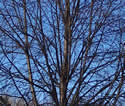 classic tight branching
classic tight branching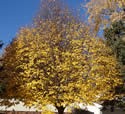 fall color
fall color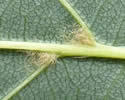 tufts of hairs in leaf vein axils
tufts of hairs in leaf vein axils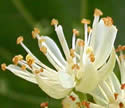 more flowers
more flowers linden borer on Little-leaf Linden
linden borer on Little-leaf Linden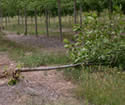 Little-leaf Linden snapped off from borer damage and heartwood rot
Little-leaf Linden snapped off from borer damage and heartwood rot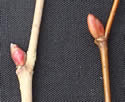 comparison of Tilia americana and T. cordata twigs
comparison of Tilia americana and T. cordata twigs
Photos by Peter M. Dziuk taken in surburban Hennepin and Ramsey counties, and rural Pine County. Tilia cordata (leaf hairs) by Zoya Akulova used under CC BY-NC 3.0.
Comments
Have you seen this plant in Minnesota, or have any other comments about it?
on: 2018-06-26 18:38:42
I have 4 of these trees in my yard and have wondering what species they were since we moved here last fall. I have never heard of little leaf linden. These are around 40’ tall. How should these be trimmed? They are rather messy as they drop small twigs regularly. Nice shade tree.
on: 2019-10-19 20:53:30
I have just found it naturalizing in a forested creek corridor in Duluth. Many age ranges, mainly seedlings, and some small to large saplings and a few small trees. Doing some digging on EDDMapS, looks like it is not listed, but Tilia japonica is listed and marked as invasive in Florida. I can show this to you during your next trip to Duluth (seedlings are easy to spot this time of year).






